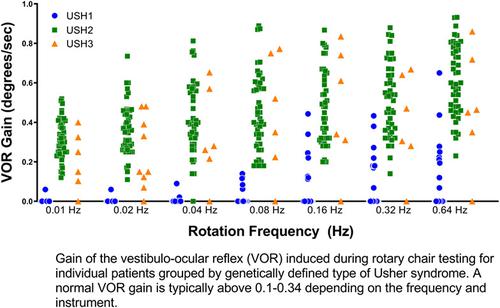当前位置:
X-MOL 学术
›
Clin. Genet.
›
论文详情
Our official English website, www.x-mol.net, welcomes your
feedback! (Note: you will need to create a separate account there.)
Vestibular phenotype‐genotype correlation in a cohort of 90 patients with Usher syndrome
Clinical Genetics ( IF 2.9 ) Pub Date : 2020-10-21 , DOI: 10.1111/cge.13868 Talah T Wafa 1 , Rabia Faridi 2 , Kelly A King 1 , Christopher Zalewski 1 , Rizwan Yousaf 2 , Julie M Schultz 2, 3 , Robert J Morell 4 , Julie Muskett 1 , Amy Turriff 5 , Ekaterini Tsilou 5 , Andrew J Griffith 1 , Thomas B Friedman 2 , Wadih M Zein 5 , Carmen C Brewer 1
Clinical Genetics ( IF 2.9 ) Pub Date : 2020-10-21 , DOI: 10.1111/cge.13868 Talah T Wafa 1 , Rabia Faridi 2 , Kelly A King 1 , Christopher Zalewski 1 , Rizwan Yousaf 2 , Julie M Schultz 2, 3 , Robert J Morell 4 , Julie Muskett 1 , Amy Turriff 5 , Ekaterini Tsilou 5 , Andrew J Griffith 1 , Thomas B Friedman 2 , Wadih M Zein 5 , Carmen C Brewer 1
Affiliation

|
Usher syndrome has been historically categorized into one of three classical types based on the patient phenotype. However, the vestibular phenotype does not infallibly predict which Usher genes are mutated. Conversely, the Usher syndrome genotype is not sufficient to reliably predict vestibular function. Here we present a characterization of the vestibular phenotype of 90 patients with clinical presentation of Usher syndrome (59 females), aged 10.9 to 75.5 years, with genetic variants in eight Usher syndromic genes and expand the description of atypical Usher syndrome. We identified unexpected horizontal semicircular canal reactivity in response to caloric and rotational stimuli in 12.5% (3 of 24) and 41.7% (10 of 24), respectively, of our USH1 cohort. These findings are not consistent with the classical phenotypic definition of vestibular areflexia in USH1. Similarly, 17% (6 of 35) of our cohort with USH2A mutations had saccular dysfunction as evidenced by absent cervical vestibular evoked myogenic potentials in contradiction to the classical assumption of normal vestibular function. The surprising lack of consistent genotypic to vestibular phenotypic findings as well as no clear vestibular phenotypic patterns among atypical USH cases, indicate that even rigorous vestibular phenotyping data will not reliably differentiate the three USH types.
中文翻译:

90 名 Usher 综合征患者的前庭表型-基因型相关性
历史上,根据患者表型,亚瑟综合征被分为三种经典类型之一。然而,前庭表型并不能准确预测哪些 Usher 基因发生了突变。相反,亚瑟综合征基因型不足以可靠地预测前庭功能。在这里,我们介绍了 90 名具有 Usher 综合征临床表现的患者(59 名女性)的前庭表型特征,年龄为 10.9 至 75.5 岁,八个 Usher 综合征基因存在遗传变异,并扩展了非典型 Usher 综合征的描述。我们发现,在我们的 USH1 队列中,分别有 12.5%(24 人中的 3 人)和 41.7%(24 人中的 10 人)的水平半规管对热量和旋转刺激有意外的反应性。这些发现与 USH1 中前庭无反射的经典表型定义不一致。同样,我们的USH2A突变队列中有 17%(35 人中的 6 人)患有囊性功能障碍,颈前庭诱发肌源性电位的缺失证明了这一点,这与正常前庭功能的经典假设相矛盾。令人惊讶的是,非典型 USH 病例中缺乏一致的基因型与前庭表型发现,并且没有明确的前庭表型模式,表明即使严格的前庭表型数据也无法可靠地区分三种 USH 类型。
更新日期:2020-10-21
中文翻译:

90 名 Usher 综合征患者的前庭表型-基因型相关性
历史上,根据患者表型,亚瑟综合征被分为三种经典类型之一。然而,前庭表型并不能准确预测哪些 Usher 基因发生了突变。相反,亚瑟综合征基因型不足以可靠地预测前庭功能。在这里,我们介绍了 90 名具有 Usher 综合征临床表现的患者(59 名女性)的前庭表型特征,年龄为 10.9 至 75.5 岁,八个 Usher 综合征基因存在遗传变异,并扩展了非典型 Usher 综合征的描述。我们发现,在我们的 USH1 队列中,分别有 12.5%(24 人中的 3 人)和 41.7%(24 人中的 10 人)的水平半规管对热量和旋转刺激有意外的反应性。这些发现与 USH1 中前庭无反射的经典表型定义不一致。同样,我们的USH2A突变队列中有 17%(35 人中的 6 人)患有囊性功能障碍,颈前庭诱发肌源性电位的缺失证明了这一点,这与正常前庭功能的经典假设相矛盾。令人惊讶的是,非典型 USH 病例中缺乏一致的基因型与前庭表型发现,并且没有明确的前庭表型模式,表明即使严格的前庭表型数据也无法可靠地区分三种 USH 类型。











































 京公网安备 11010802027423号
京公网安备 11010802027423号